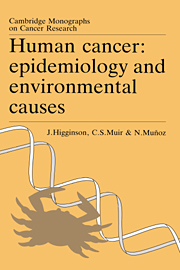Book contents
- Frontmatter
- Contents
- Contributors
- Preface
- Acknowledgements
- Historical introduction
- PART I Epidemiological methods
- PART II Causative factors in human cancer
- PART III Legal and ethical considerations
- PART IV Introduction: total and specific site epidemiology
- PART V Buccal cavity
- PART VI Digestive system
- PART VII Respiratory system
- PART VIII Bone and soft tissue
- PART IX Skin
- PART X Breast and genitourinary system
- PART XI Eye and nervous system
- PART XII Thyroid and other endocrine glands, lymphoid and hematopoietic system
- 52 Thyroid and other endocrine glands
- 53 Burkitt's lymphoma
- 54 Hodgkin's disease (HD)
- 55 Non-Hodgkin's lymphoma (NHL) and mycosis fungoides
- 56 Multiple myeloma and macroglobulinemia
- 57 The leukemias
- PART XIII Cancers in children and multiple primary cancers
- Conclusions
- Appendix 1 Cancer statistics
- Appendix 2 A glossary of epidemiological terms
- Appendix 3 Acronyms and abbreviations
- Supplement
- Index
54 - Hodgkin's disease (HD)
Published online by Cambridge University Press: 03 May 2010
- Frontmatter
- Contents
- Contributors
- Preface
- Acknowledgements
- Historical introduction
- PART I Epidemiological methods
- PART II Causative factors in human cancer
- PART III Legal and ethical considerations
- PART IV Introduction: total and specific site epidemiology
- PART V Buccal cavity
- PART VI Digestive system
- PART VII Respiratory system
- PART VIII Bone and soft tissue
- PART IX Skin
- PART X Breast and genitourinary system
- PART XI Eye and nervous system
- PART XII Thyroid and other endocrine glands, lymphoid and hematopoietic system
- 52 Thyroid and other endocrine glands
- 53 Burkitt's lymphoma
- 54 Hodgkin's disease (HD)
- 55 Non-Hodgkin's lymphoma (NHL) and mycosis fungoides
- 56 Multiple myeloma and macroglobulinemia
- 57 The leukemias
- PART XIII Cancers in children and multiple primary cancers
- Conclusions
- Appendix 1 Cancer statistics
- Appendix 2 A glossary of epidemiological terms
- Appendix 3 Acronyms and abbreviations
- Supplement
- Index
Summary
Introduction
In this relatively uncommon tumor, an infectious etiology has for long been suspected but never confirmed. Remarkable progress has also been made in treatment during the last 25 years which has had a significant effect on mortality rates.
Histology, classification and diagnosis
Hodgkin's disease (HD) is a malignant lymphoma characterized by the presence of multinucleated giant (Reed-Sternberg) cells. There are several histological sub-types and various classifications. The widely used Rye classification describes four sub-types that differ not only morphologically but in their clinical and epidemiological behavior. These four sub-types in order of best to worst prognosis are: lymphocytic predominance, nodular sclerosis, mixed cellularity and lymphocytic depletion (Lukes et al., 1966).
From the epidemiological point of view, three distinct forms of HD have been proposed: a childhood form (0–14 years), a young adult form (15–34 years), and an older adult form (55–74 years). Some authors regard these as separate entities (MacMahon, 1966) while others consider that they result from the interplay of environmental and host factors influencing the natural history of a single disease.
Correa and O'Conor (1971) describe three epidemiological patterns of HD:
Pattern I – is most common in developing countries and is characterized by high rates in male children, low incidence rates in the third decade and a second peak in older age groups. Most cases are classified as mixed cellularity or lymphocyte depletion with poor prognosis.
- Type
- Chapter
- Information
- Human CancerEpidemiology and Environmental Causes, pp. 453 - 458Publisher: Cambridge University PressPrint publication year: 1992

